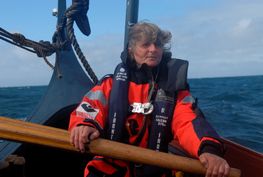Present-day skipper
Not much has changed since the Viking Age with regard to the skipper's role on board. The skipper and the coxswain have – just like 1000 years ago – overall responsibility for the ship, crew, equipment, and for reaching their destination.
Fact: The words skipper and coxswain were not used in the same way as today. The skipper on board the Sea Stallion is the ship's captain or commander and the coxswain is the skipper's second in command and deputy. But in Viking times it may have been the other way round. The word styrimaðr (coxswain) – or styresmand – was used of the owner of the ship and of the person who had military command, whereas skipari (skipper) was used of the second in command or the ordinary crew members.

The skipper on board the Sea Stallion bears a great responsibility. It is the first time for a 1000 years that a Viking warship is to cross the North Sea, sailing from Denmark to Ireland. It is the skipper’s responsibility that the crossing proceeds safely, that the ship is navigated in a proper manner. Also that the men all know their duties during the voyage and that all precautionary measures are taken to prevent damage to the ship or injuries to the persons on board.
He does not, however, take decisions completely single-handedly. The skipper has two coxswains who steer the ship for him. He can consult them with regard to the voyage – about the ship’s course and its route, where it is to dock, and when it is to set sail again and proceed.
Further to this, the ship is divided up into six rooms or sections, each having two foremen. The foremen are the skipper’s right hand among the crew. They must make sure that everybody observes the duty roster, are in control of their duties, have their life jackets on and are comfortable on board the ship.
By: Louise Kæmpe Henriksen

Litterature
Robberstad, Knut: Gulatinglovi, Oslo: Det Norske Samlaget 1981 s. 286 - 284 Kap. 5, 7, 8 og 9
Falk, Hjalmar: Fornordisk Sjöfart, Båtdokgruppen 1995 s 25 - 32